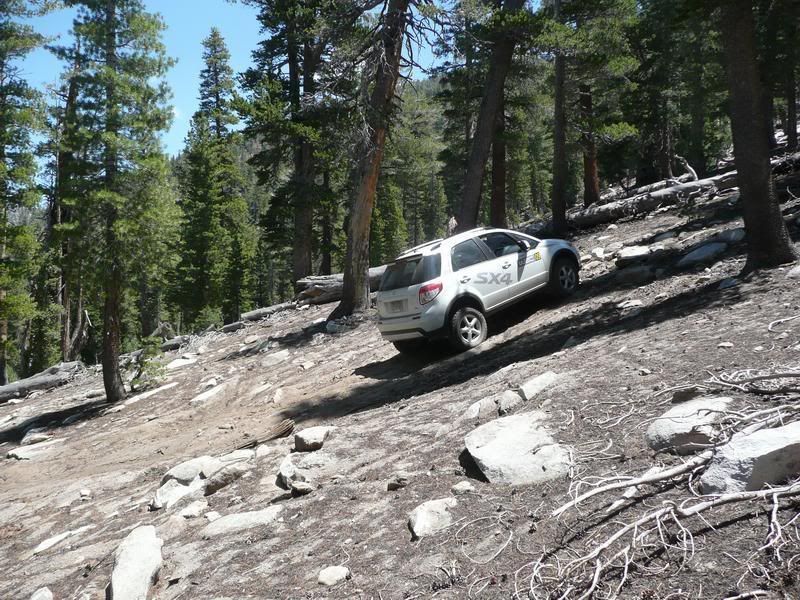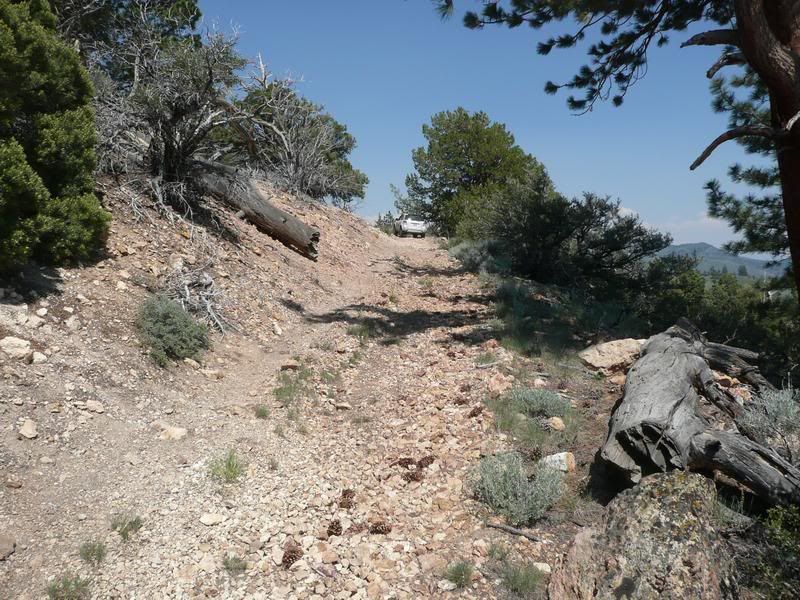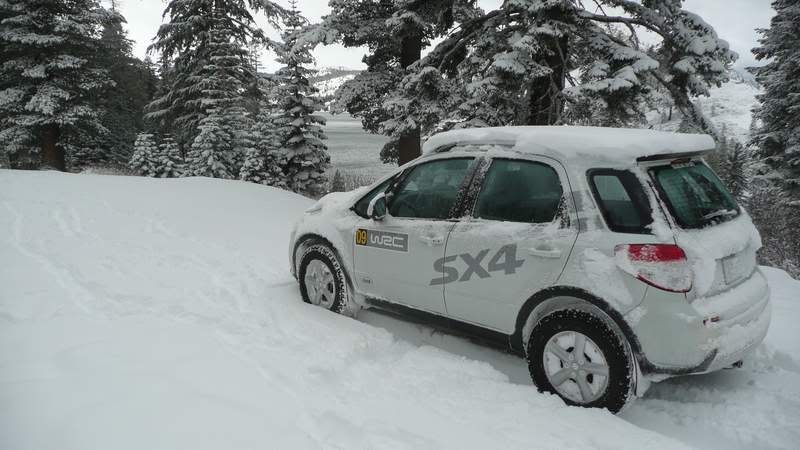a 3rd AWD system - 5EAT
So there is a 3rd AWD system in the subaru vehicles. I have an '08 Outback 2.5XT. This is a 2.5L Turbo motor with the 5EAT - 5 speed automatic. This transmission has a 'normal' torque split of 45/55 (F/R). The AWD is a more advanced 'predictive' clutch pack. The rear also contains a Viscus LSD. Overall the system worked great for me on my recent trip to Big Bend when paired with Yokohama ATS tires.
http://www.expeditionportal.com/forum/showthread.php?t=59337
I don't have any experience with a Manual but the gearing on the Outback seemed adequate. The only times I saw some issues were steep descents where there was limited braking (with the sport-shift in 1st) and the ABS would kick in a little sooner then I would like.
Here is an excellent write-up from LegacyGT.com:
http://legacygt.com/forums/showthre...awd-systems-honest-attempt-48112.html?t=48112
There is a lot of confusion about the differences between the various Subaru AWD systems:
Continuous (for 5MT)
Active (for 4EAT)
VTD (for 5EAT)
availability or non-availability of Rear LSD
So heres an attempt to explain the differences....
1. Continuous AWD System:
The manual transmission’s all-wheel drive is referred to as a continuous all-wheel drive system. It uses a center differential located inside the transmission case that is controlled by a viscous coupling device. In effect, the center differential is a limited-slip differential.
In normal operation, power is distributed equally to the front and rear wheels. Plates are alternately attached to the front and rear output shafts inside the viscous coupling. When a rotational difference occurs between the front and back wheels, the plates inside the viscous housing shear inside the contained fluid (a type of silicone) heating it and causing the fluid to thicken. The thickened fluid causes the plates to transfer torque from those that rotate faster (the slipping wheels) to the plates that rotate slower (the wheels with the best traction).
This no-maintenance system is simple, compact and virtually invisible in its operation. The system can distribute torque from a 50:50 torque split for maximum traction to mostly front or rear wheel drive.
(Source:
http://www.autoworld.com/news/Subaru..._All-Wheel.htm)
A. Continuous AWD with Rear LSD: Available with 5MT on WRX, Legacy GT, Outback 2.5i, Outback XT and with 6MT on Spec.B
B. Continuous AWD without rear LSD: Available with 5MT on Impreza 2.5i, Outback Sport and Legacy 2.5i
2. Active AWD System:
Active all-wheel drive is a term coined by Subaru to differentiate the all-wheel drive system in the automatic transmission (4EAT) from other "reactive" all-wheel drive systems on the market today. What makes this all-wheel drive system so special is its ability to anticipate traction needs and act before a wheel slips.
The mechanism that transfers torque fore and aft is contained within the transmission’s tailshaft. To the casual observer it looks just like a typical hydraulic clutch found in any automatic. The key difference in this clutch pack is its operation. It’s designed to slip according to how much all-wheel drive is needed. When an automatic’s clutch slips, it is due to a malfunction and will eventually burn up. But the multi-plate transfer (MPT) clutch uses a special friction material that easily withstands the friction loads generated during torque transfer. (Also referred to as VTC = Variable Transfer Clutch)
The MPT’s operation is controlled by the Transmission Control Unit (or TCU) and constantly changes dependent on how the vehicle is being driven. To get more all-wheel drive, the TCU increases the hydraulic pressure to the clutch for less slippage. Less all-wheel drive calls for more slip and the TCU reduces the hydraulic pressure to the clutch.
Under normal, dry pavement operation torque split is about 90% front and 10% rear. This distribution helps to compensate for the car’s weight distribution and resultant smaller effective rolling diameter of the front tires. As weight transfers to the rear of the vehicle, (i.e., under acceleration), the TCU shifts the torque split more toward the rear wheels. Under hard braking, torque is directed forward. Torque distribution is changed based upon how the vehicle is being driven. Throttle position, gearshift lever position, current gear and other factors combine to influence the TCU and it, in turn, selects a software map that determines how aggressively torque split will be adjusted.
Two speed sensors are used by the TCU to detect wheel slippage. One sensor monitors the front axle set, the other the rear axle set. Pre-programmed variables help the TCU differentiate between slipping wheels and normal wheel speed differentials as what occurs when cornering. A speed differential (front-to-rear) of up to 20% signals the TCU that the vehicle is cornering and torque is distributed to the front wheels to help increase traction during the turn. Anything above 20%, however, indicates to the TCU that wheel slippage is occurring and torque is then distributed to the rear wheels.
Another feature of the all-wheel drive system is its interaction with the anti-lock brake system. When ABS is engaged, the transmission selects third gear, reducing the unpredictability of engine braking and, thus, reducing the possibility of wheel lock-up. But all four wheels are still connected to the engine through the AWD system and are brought back up to overall vehicle speed quicker and can, therefore, be controlled again sooner. In a two-wheel drive system if the locking wheel isn’t a drive wheel, it can only be brought back up to overall wheel speed by whatever traction exists between it and the road. The quicker a wheel is controlled the better the stopping performance
(Source:
http://www.autoworld.com/news/Subaru..._All-Wheel.htm)
A. Active AWD with Rear LSD: Available with Outback 2.5i
B. Active AWD without Rear LSD: Available with 4EAT on Impreza 2.5i, Legacy 2.5i, Legacy 2.5i Ltd
3. Variable Torque Distribution (VTD):
It has the MPT (multi plate transfer) clutch aka VTC as found in the Active AWD system but it also has a planetary-type center differential and a Rear LSD. The center differential provides the ability to have a default torque split of 45/55 front/rear (as against the 90/10 split in Active AWD). In every other aspect it is similar to the Active AWD in that it anticipates wheel slippage instead of reacting to it as in the case of a MT. We can say the the VTD is an advanced Active AWD system
Available with 4EAT on Impreza WRX
Available with 5EAT on Outback XT, Outback 3.0R, Legacy GT
4. Driver Controlled Center Differential (DCCD):
Uses an electronically managed multiplate transfer clutch and a mechanical limited-slip differential in conjunction with a planetary gear-type center differential to control power distribution between the front and rear wheels. Normally, DCCD splits power 41% front and 59% rear. Sensors monitor parameters such as wheel slippage, steering angle, throttle position and braking to help determine torque distribution and direct it to the wheels with optimum traction. DCCD also features a helical-type limited-slip front differential and a Torsen® limited-slip rear differential.
Available with 6MT on Impreza WRX Sti
Does my Subaru have a Rear LSD?
Another point of confusion is which Subarus have Rear Limited Slip Differentials (Rear LSD) and which ones do not. For this you can refer to the list of Subaru AWDs above where I have also listed the Subaru models which have that type of AWD. But to make things even clearer heres a list of Subarus with and without Rear LSD:
Subarus without Rear LSD:
Impreza 2.5i (5MT and 4EAT)
Outback Sport (5MT and 4EAT)
Legacy 2.5i (5MT and 4EAT)
Legacy 2.5i Ltd. (4EAT)
Subarus with Rear LSD:
Impreza WRX (5MT and 4EAT)
Outback 2.5i (5MT and 4EAT)
Outback XT (5MT and 5EAT)
Outback 3.0R (5EAT)
Legacy GT (5MT and 5EAT)
Spec.B (6MT)
WRX Sti (also has Front LSD)
As we all know that the center differential can split the torque in between the front and the rear axles depending on the front/rear wheel slippage. But its the Front and the Rear LSDs which can split the power between left and right wheels. So it is very advantageous to have at least the Rear LSD if not the Front LSD. If the left rear wheel slips the Rear LSD can transfer the power to the right rear wheel.
Subaru does not offer Rear LSDs in its lower models except in Outback 2.5i!! which is understandable since it is designed for off-road conditions. (This might explain the mpg difference in Outback 2.5i and Legacy 2.5i)
Which is Better?
Now that brings us to the next point of debate as to which one is better?
So here's an excerpt from an article I found:
(Source:
http://www.cars.com/carsapp/cars/?sr...all_wheel.tmpl)
"Simpler AWD systems “bias” the power to the front or the rear in this way and react to slippage when it occurs. Subaru's “continuous” AWD system is this type. More advanced systems are designed to be proactive rather than reactive. For example, Subaru’s “active” AWD is claimed to anticipate and prevent slippage for a seamless driving experience. Audi's quattro and related Volkswagen 4MOTION AWD systems route power based on vehicle dynamics: Rear tires have greater grip during acceleration, so during that action the rear wheels receive more of the engine’s power. In turns, the outside front wheel has the most grip and thus gets the most power, followed by both rear wheels.
With advanced AWD like this available on cars such as the Porsche 911 Carrera 4, it’s clear that four driven wheels are no longer the province of high-ridin’ mud buggies. For surefooted handling during acceleration — even on bone-dry roads — AWD is tough to beat."
As per the author of this article the Continuous AWD system found on Subarus with 5MT and 6MT is a simpler system in that it is more reactive than proactive. Whereas the Active AWD systems (with Variable Transfer Clutch) found on 4EAT Subarus and the VTD (which is an advanced Active AWD system) found on 5EAT Subarus are proactive in predicting wheel slippage conditions and hence react faster. But obviously the Continuous AWD systems have the advantages of being less complex and hence less prone to failures and low repair costs.
So again which system is the best? I would say the order could be as follows:
DCCD with Front and Rear LSDs - WRX Sti
VTD - 4EAT on WRX and 5EAT on Outback XT, Outback 3.0R and Legacy GT
Active AWD with Rear LSD: 4EAT on Outback 2.5i
Tie. Depends on what you need more? proactive AWD system or the Rear LSD (if offroading)
Active AWD without Rear LSD: 4EAT on Impreza 2.5i, Legacy 2.5i and Legacy 2.5i Ltd
Continuous AWD with Rear LSD: 5MT on WRX, Legacy GT, Outback 2.5i, Outback XT and 6MT on spec.B
Continuous AWD without Rear LSD: 5MT on Impreza 2.5i and Legacy 2.5i
Subaru saves its best AWD system for the Impreza WRX Sti which has the DCCD system with front and rear LSDs.
I wasnt aware that the Outback 2.5i has the Rear LSD. Thats an advantage over the Legacy 2.5i.
Disclaimer: These are my deductions from what I have read on the internet and limited by the capability of my 3lbs. So please no one should get offended . Also, if you feel any of this information is incorrect and needs to be updated then please feel free to enlighten all of us.






